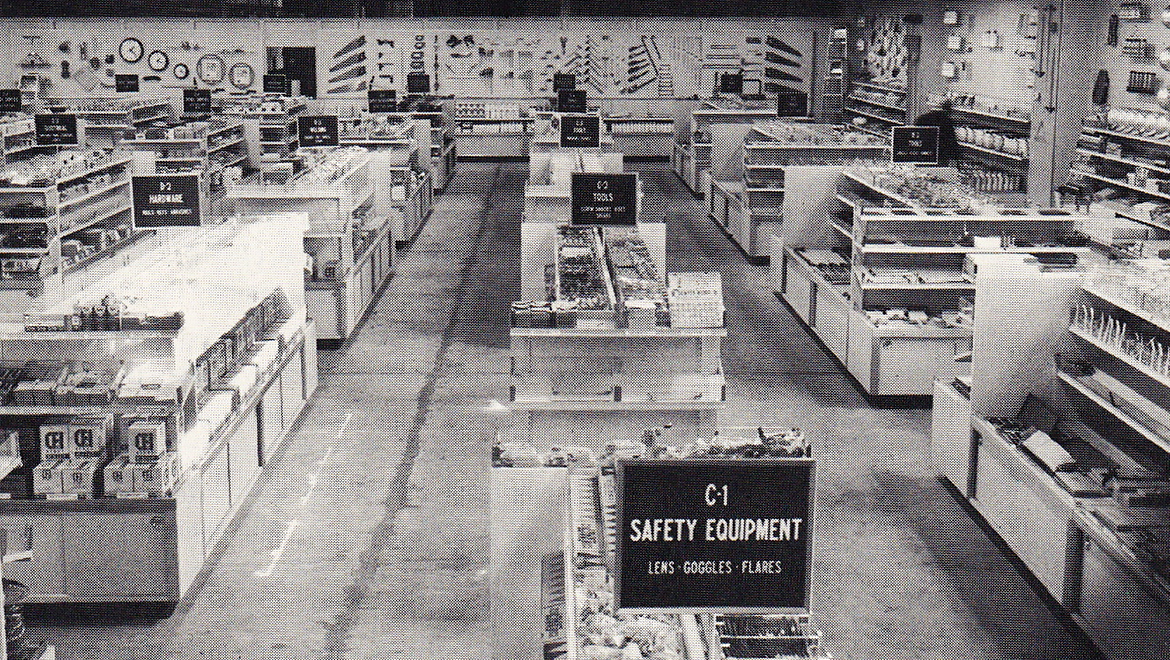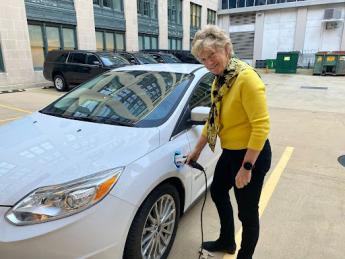
GSA at 75: A cost-efficient federal marketplace
This blog is part of a series of GSA.gov entries that highlight the agency’s past, present and future as it marks 75 years on July 1.
Since 1949, the General Services Administration has been the federal government’s broker of goods and services for other agencies – from the Administration for Native Americans to the Western Area Power Administration and in between – connecting them with trusted suppliers.
GSA manages an online federal marketplace where 438 federal agencies can shop from companies that sell goods and services worth more than $100 billion each year. Because of the agency’s vast buying power, that marketplace supplies the federal government with a host of things:
- Office technology, computer systems, and artificial intelligence tools.
- Facilities and construction.
- Security and protection services.
- Transportation and logistics services, including travel across government.
- Other professional services like training, medical, and office management.
It is not surprising that this makes the U.S. government the world’s largest buyer of goods and services. Some of GSA’s biggest customers are the departments of Defense, Homeland Security, Health and Human Services, Justice, and Agriculture. After these five are all other agencies combined.
It’s a busy place.
Where GSA began
GSA took over management of the federal government’s “General Schedule of Supplies” from the Treasury Department when President Harry S. Truman created the agency after World War II to streamline the federal government’s administrative work. Its original mission also included disposing of war surplus goods and stockpiling strategic supplies for wartime, managing and storing government records, and handling emergency preparedness. While many of those original functions have been tasked to different federal agencies now, GSA continues to handle a wide range of responsibilities under its purview.
Federal Acquisition Service
GSA connects suppliers with federal agency buyers through the Federal Acquisition Service. Vendors – a third of which are small businesses – are vetted to ensure they can deliver the goods and services needed. Once approved, they can compete for federal contracts which FAS helps to facilitate.
In 2019, FAS undertook a significant modernization effort to make buying and selling easier and more efficient. To dramatically improve the buying experience and ensure consistency across the federal marketplace, the 24 Multiple Award Schedules were consolidated into one single Schedule — a major improvement that took years to accomplish.
FAS also offers comprehensive assisted acquisition services for federal partners seeking specialized procurements, offering acquisition, project and financial management services. AAS recently helped the Advanced Research Projects Agency for Health’s small business programs contract for services to enable advances in science, technology and systems. AAS also invests federal research funds in critical priorities.
The federal fleet

In 1954, GSA Fleet was established to centralize the governmentwide motor pool. Today, GSA Fleet offers vehicle purchasing, vehicle leasing, short-term rentals, and ancillary fleet solutions to support more than 75 federal agencies.
GSA provides vehicles to support various missions such as food inspection, federal law enforcement, military recruitment, and emergency services, and manages over 240,000 non-tactical and non-postal vehicles – sedans, passenger vans, trucks, buses, and ambulances – in the U.S., Europe, South America, and the Pacific Rim.
GSA Fleet introduced alternative fuel vehicles in the 1970s, created a Fleet Management System in the 1980s, and implemented electronic vehicle ordering in the 1990s. Currently, the team is focused on the 2021 Executive Order, which calls for all new light-duty acquisitions to be zero-emissions vehicles by 2027 and all new government vehicle acquisitions by 2035. The Federal Acquisition Service and Public Building Service teams work together to educate, plan and procure zero-emission vehicles, as well as the infrastructure and charging stations needed to power those vehicles and meet this goal.
Through the years,GSA’s buying power has influenced improvements to products and services. With automotive, technical, trade and medical experts, as well as other government agencies, GSA has introduced federal standards for automotive safety devices. Well before these features became industry standards, GSA required the automotive industry to provide federal employees seat belts, safety glazing, exhaust emission control, backup warning lights, driver airbags, and outside rearview mirrors. Today, these safety features are standard in all vehicles.
GSA’s auctions touch the stars
Have an urge to own a gray, two-door coupe 2023 Aston Martin DB11? Or a 2010 Beechcraft C90GTi airplane? Maybe just some office supplies like shredders and copy machines, jewelry, diamonds, or wedding dresses? All of those — and more — have come through the Personal Property Management System, a GSA tool to help federal agencies transfer or donate items to eligible recipients, and GSAAuctions.gov, which is open to the public.
GSA also helps ensure historic materials go to educational institutions and museums where they’ll be shared with the public, such as the space shuttle now at Udvar Hazy, along with manuals from the beginning of the space program.
These donations and auctions save taxpayer dollars by avoiding unnecessary procurements, reducing emissions associated with the production of new items, and keeps items out of landfills.
Telecommunications
When GSA was established, most government agencies bought their own telephones and used the same lines as private citizens, resulting in overloads, particularly during World War II. In the 1960s, GSA created the Federal Telecommunications System (FTS). Called the “voice network of the government,” FTS was a nationwide system of phone lines and high-speed switching facilities leased and managed by GSA for federal use. By grouping federal customers this way, GSA provided a unified system for both day-to-day and emergency communications services.
Since the government was able to buy in bulk and save money, FTS grew to include new services like data transport as networked computers came on the scene in the 1980s. The legacy of FTS lives on in GSA’s Enterprise Infrastructure Solutions contracts, which offer agencies everything they need to access a wide assortment of cutting-edge telecommunications and enterprise network services.
Air travel
GSA expanded into contracting for air travel in 1980 and introduced the City Pair Program, which negotiates favorable airfare rates for official government travelers. When it started, the service covered 11 markets; it now covers over 14,000 line-item markets. City Pair fares have no cancellation or change fees, no blackout dates, no minimum or maximum length of travel requirements, are fully refundable, and offer last-seat availability. The program has been a governmentwide Category Management Best-in-Class (BIC) solution since 2017. As the largest strategically-sourced procurement for negotiated airfares in the world, GSA’s City Pair Program capitalizes on the scale of federal travelers to negotiate lower rates on flights between key cities and save taxpayer dollars.
As of July 16, nine air carriers received FY2025 contracts, estimated to save $2.45 billion in FY25 on official travel expenses. “For the first time in several years, we are increasing the number of airlines participating in the program, which means we’re opening new markets and creating more competition,” said Acting FAS Commissioner Tom Howder.
Government charge card
In 1998, GSA introduced GSA SmartPay, the first governmentwide charge card program.
As of fiscal year 2024, more than 4.5 million federal employees use it to make official government purchases, travel, fuel and maintain fleet vehicles/equipment, and more. The program has handled more than $694 billion in agency transactions and generated more than $6.3 billion in refunds (cash back) to agencies to reinvest in their missions. It is the world’s largest government charge card and commercial payment solutions program.
What’s ahead?
FAS has positioned itself to not only manage the federal government’s online marketplace, but reinvent it.
- In 2023, the agency launched buy.gsa.gov and reorganized to align more with customers.
- Earlier this year: a new FAS Catalog Platform was rolled out to help vendors more easily manage contracts. GSA has been working to set the standard for government AI adoption.
- In April 2024, GSA released itsGenerative AI and Specialized Computing Infrastructure Acquisition Resource Guide, which helps agencies make choices about acquiring technology.
- Cloud services must get FedRAMP authorization in order to be used and adopted by government agencies. The new Emerging Technology Prioritization Framework (published in June) prioritizes the authorization of cloud service offerings that have to do with emerging technologies such as AI.
- On the horizon are plans to completely overhaul electronic travel service for civilian agencies, and implement systems that use timely data to ensure fair pricing at the transaction level.

 U.S. General Services Administration
U.S. General Services Administration
